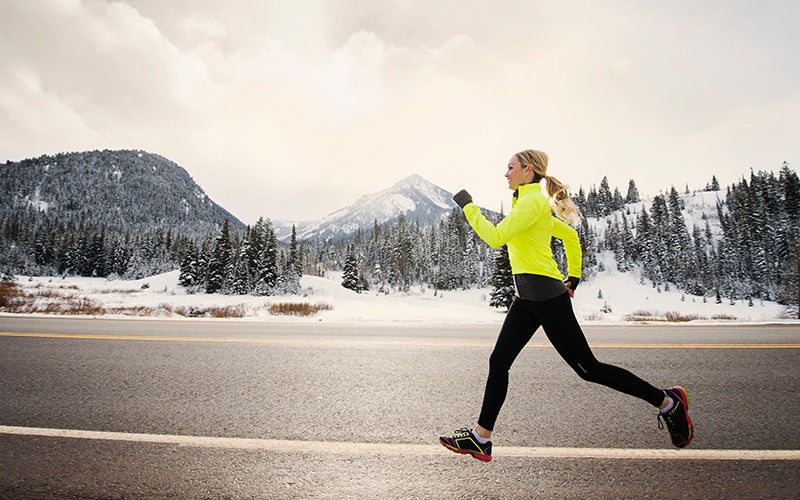11 Reasons to Go Running in the Rain
 ©Erik Isakson
©Erik Isakson
Warm weather is on the way out, but a bit of rain is no reason to skip your usual running session. In fact, running in the rain is a great opportunity to boost your immune system, mind, and confidence all at once! Keep reading to find out how to make running in the rain a glorious experience.
5 Tricks to Make Your Run in the Rain More Enjoyable
#1 Warm up indoors
Running is a natural way to heat your body, and getting your blood pumping indoors is a great way to get warmed up for your cold weather run. It also takes longer to activate your muscles in cold weather, so preparing them beforehand can speed up the process and make your run more enjoyable from start to finish. Dynamic stretches, squats, and jumping jacks are all great ways to prep your body for this kind of activity.
#2 Choose the right trail
When the sun is shining and there’s not a cloud in the sky, it’s possible to run almost anywhere, from sandy beaches to untamed forest trails. But rain creates puddles and slippery paths, all of which can be dangerous obstacles on your usual run. When the weather isn’t on your side, opt for a paved path or track that’s built to withstand the elements rather than traditional trail running. City streets, for example, are an excellent place for jogging in the rain.
Whether or not you’re able to run easily during the winter will depend on the type of snow outside. Fresh, early winter snow poses little risk of slipping because it’s light and sticky. But when the snow is packed and iced over during the deeper parts of winter, going for a run can be highly risky. During this time, try to stick to running areas that are treated with gravel or salt to avoid any accidents.
Knowing where you’re going to run can also be a huge motivator. If you’re prepared to run a certain distance and know about how long it will take, you can go on a moment’s notice (and design a playlist that’s the perfect length!).
Unfortunately, running in the rain isn’t so touch and go because you need to be more prepared for the elements. Tricks like warming up beforehand may make the process longer, but they’ll greatly increase your comfort levels during the run.
#3 Take a Long Slow Run Instead of a Short, Intense Sprint
Running trails can quickly become messy and slippery in wet weather, and running quickly in these conditions can put you at a great risk of running. Instead of short and quick runs, long, slow jogs are equally challenging and less dangerous.
Intense training is also more stressful on the respiratory system in extremely cold weather than in warm weather. Whenever you’re having trouble breathing, make sure to take breaks and give your body time to adjust to the cold.
#4 Cool Down with a Warm Shower
It’s always a good idea to reward yourself with a shower after a sweaty run, but especially so on cold, rainy days. Take the last moments of your run to move slowly and begin your cooldown, then head directly to the shower with no stops in between. This will help you avoid catching a cold and heat you up more quickly, too. Then, take the opportunity to do some stretches and mobility exercises when your muscles are all hot and loose from the warm water.
#5 Run with Music
An excellent playlist is a great way to keep yourself motivated while running through inclement weather. If music isn’t enough to distract you from the discomfort, a podcast or audiobook might do a better job of occupying your mind.
What to Wear on Your Rainy Day Runs
Those who dwell in colder climates are often known to say, “there’s no such thing as bad weather, only bad clothing.” That’s because you can absolutely be warm and cozy at frigid temps with the right ensemble. Keep reading to find out what gear will keep you the most comfortable on your rainy day runs, from sneakers to socks.
#1 Running Shoes: Should They Be Waterproof or Not?
Though you don’t have to wear waterproof running shoes, they will make your rainy run infinitely more comfortable. After all, what could be worse than wet running shoes? Keep in mind that these types of shoes don’t allow for much breathability in order to keep your feet dry. Swap them out for another option when warm weather returns to avoid sweaty feet.
Along with being waterproof, look for running shoes that have soles with strong grips to better protect you from slippery surfaces. Many trail running shoes are fitted with this kind of feature.
Our tip: Finding the right shoes is a science in itself. Luckily, we make it easy to find the right option for your needs in this article.
#2 Invest in Running Socks!
You might be wondering, why should I bother with running socks when my regular socks work just as well? If you’re planning on running in the rain, it’s worth the investment for a few reasons.
For one, well-fitted running socks won’t slip, which will mean fewer distractions on your already obstacle-filled run in the rain. Many options are also specially designed for intense efforts and built to stand up to all weather conditions. On the other hand, traditional socks are more likely to absorb water, slip around in your shoes, and ultimately lead to blisters on your feet.
#3 Choose Tight-Fitting Pants That Are Designed for Running
Because our legs do the majority of the work during a run, they rarely get cold. Even in temperatures as low as 10 degrees, many runners are content to wear shorts. If you do find yourself getting cold, then it’s a good idea to invest in a pair of waterproof tights or pants. Avoid any old sweatpants, which easily absorb water and can quickly become moist and soggy on rainy days.
#4 When in Doubt, Dress Like an Onion
Onion layering is when you wear several light, easy-to-remove layers during a run. That way, you can smoothly adjust your outfit if you get too hot or cold.
Start with the first layer, which could be either a T-shirt or long sleeved, form-fitting top depending on just how cold it is. Next up is a waterproof running jacket or a rain jacket that’s optimized for physical activities.
Even if you shiver a bit when you leave your house, this amount of clothes will be enough to keep you warm once you get going. If you wear too many layers, you may get hot quickly and begin sweating through your clothes.
Above all, make sure to fit tight-fitting clothes that won’t budge from even the strongest gusts of wind. By keeping your skin fully covered at all times, these garments ensure that your body temperature doesn’t drop.
#5 Protect Cold-Sensitive Body Parts
Our hands, neck, and ears are all extremely sensitive to the cold, which is why it’s so important to keep them covered on winter runs. Windproof and waterproof gloves will protect your fingers from dry skin, and multi-functional scarves can double as both an ear and neck warmer if wrapped correctly. Finally, a beanie, headband, or earmuffs will be enough to prevent heat loss from your head. You can also wear a visor or baseball cap to protect your eyes from the rain.
Our tip: Always carry two multi-functional scarves when the weather is uncertain: one for the neck and one for the head. If you get too hot at any time, just wrap one around your wrist instead.
#6 Make Yourself Visible
With rainy weather comes darkness and less visibility for runners and the obstacles they might encounter. Drivers have a harder time spotting runners in inclement conditions, so make it easy for them by wearing bright, easily visible clothing.
Why Bother Running When It’s Stormy Outside?
Running in the rain can strengthen both your body and mind. But convincing yourself to run in the rain is a whole other story. Here are four reasons to consider going for a rainy run.
Running In the Rain Can Benefit Your Immune System
Rainy runs cause your immune system to grow just as it does your muscles and stamina. Movement combined with the differences between outside temperature and body temperature forces you to adapt. Thermoregulation teaches your body how to better store heat and cool down more efficiently in the summer, and running in the rain encourages this process. The more you train in different climates, the better you’ll be able to perform in all of them.
It Can Strengthen Your Mind
Deciding to do something good for yourself in spite of bad weather will give you feelings of responsibility and motivation. Going out of your comfort zone will help you learn how to survive any conditions and give you confidence both on and off your running trail.
It Can Give You the Motivation to Go After a Goal
There are some extreme weather conditions you should avoid running in (think blizzards, icy ground, or extra high winds). But a bit of light rain or snow is no reason to cancel your run. The next time you’re struggling to get off of the couch, motivate yourself by thinking of how much pride you’ll feel after accomplishing a rainy run. The more you do it, the less difficult it will become.
Conclusion
- Running in the rain can strengthen your immune system, your confidence, and your attitude towards running.
- The right clothing for running in the rain is functional sportswear with light layers that are easy to remove. Wet clothes or wet shoes can make running in the rain extremely uncomfortable, so always opt for the right gear.
- Use a waterproof running jacket or sports rain coat to keep your dry clothes dry and protect yourself from moisture.
Sources for this article
We at foodspring use only high-quality sources, including peer-reviewed studies, to support the facts within our articles. Read our editorial policy to learn more about how we fact-check and keep our content accurate, reliable, and trustworthy.

































